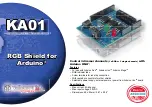
5.1 Introduction to the Dynamic Brake
5.1.1 SERVOPACK Models with a Built-In Dynamic Brake
5-2
5.1
Introduction to the Dynamic Brake
Dynamic braking is a method in which the kinetic energy of the Servomotor is converted to
electrical energy, and then this energy is consumed as thermal energy with a resistor to brake
the motor.
The smaller the resistance of the Dynamic Brake Resistor, the faster the Servomotor can be
stopped and the shorter the coasting distance will be. However, the larger the resistance of the
Dynamic Brake Resistor, the more time will be required to stop the Servomotor and the longer
the coasting distance will be.
Refer to the following section for details on the coasting distance.
5.4 Coasting Distances for Dynamic Braking
Dynamic braking can be used when an alarm occurs, when the servo is turned OFF, during an
emergency stop, and when overtravel occurs by setting Pn001 = n.
X (Motor Stopping
Method for Servo OFF and Group 1 Alarms) to 0 or 1.
SERVOPACKs are available as models with a built-in dynamic brake (SGD7S-1R9D to 170D)
and models without a built-in dynamic brake (SGD7S-210D to 370D).
5.1.1
SERVOPACK Models with a Built-In Dynamic Brake
SGD7S-1R9D to 170D SERVOPACKs are equipped with the built-in circuit required to use the
dynamic brake. A Dynamic Brake Resistor is not required when operating the SERVOPACK
within its rated range. However, an External Dynamic Brake Resistor must be connected to the
SERVOPACK to operate the SERVOPACK in the following manner.
•
When specifying the brake torque when stopping with the dynamic brake.
•
When operating with a load moment of inertia that exceeds the rating.
Refer to the following section for how to connect the Dynamic Brake Resistor to the SERVO-
PACK.
5.2.3 Connecting Dynamic Brake Resistors
5.1.2
SERVOPACK Models without a Built-In Dynamic Brake
SGD7S-210D to 370D SERVOPACKs are not equipped with a built-in dynamic brake.
To use dynamic braking, you must select the Resistor, create the circuit, and set the parameters.
Refer to the following section for details on the dynamic brake circuit.
5.3.3 Wiring the Dynamic Brake Circuit
Refer to the following section for details on selecting the Dynamic Brake Resistor.
5.3.2 Selecting the Devices Required for the Dynamic Brake Circuit
Refer to the following section for details on parameter settings for the dynamic brake.
5.3.4 Parameter Settings for the Dynamic Brake Circuit
Coasting Distance
During dynamic braking, the Servomotor rotates due to inertia until the electrical energy is con-
sumed. The travel distance at this time is called the coasting distance.
Parameter
Meaning
When Enabled
Classification
Pn001
(2001h)
n.
0
(default setting)
Stop the motor by applying the
dynamic brake.
After restart
Setup
n.
1
Stop the motor by the applying
dynamic brake and then release the
dynamic brake.
n.
2
Coast the motor to a stop without the
dynamic brake.
Term
















































